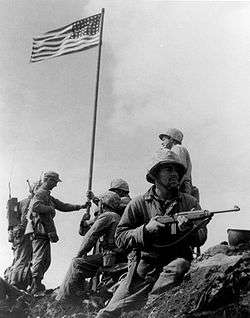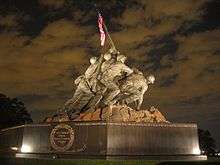Henry Oliver Hansen
| Henry Oliver Hansen | |
|---|---|
|
Hansen as a paratrooper in 1942 | |
| Born |
December 14, 1919 Boston, Massachusetts |
| Died |
March 1, 1945 (aged 25) KIA Iwo Jima |
| Allegiance | United States of America |
| Service/branch | United States Marine Corps |
| Years of service | 1938–1945 |
| Rank | Sergeant |
| Unit | 2nd Battalion, 28th Marines |
| Battles/wars |
Bougainville Battle of Iwo Jima |
| Awards |
Purple Heart Medal Combat Action Ribbon |
Henry Oliver "Hank" Hansen (December 14, 1919 – March 1, 1945) was a United States Marine Corps sergeant who was killed in action during the Battle of Iwo Jima in World War II. He was one of the members of the combat patrol that climbed, captured, and actually helped raise the first of two U.S. flags on top of Mount Suribachi on February 23, 1945. He was incorrectly identified as being one of the six second flag-raisers in the well known flag-raising photograph taken later on the same day by Associated Press photographer Joe Rosenthal until January 1947.
Early life
Hansen was born in Somerville, Massachusetts, with one sister and three brothers. He graduated from Somerville High School in 1938 and joined the Marine Corps.
U.S. Marine Corps
World War II

Left to right: 1st Lt. Harold G. Schrier (crouched behind radioman), Pfc. Raymond Jacobs (radioman), Sgt. Henry "Hank" Hansen (soft cap, holding flagstaff), Pvt. Phil Ward (holding lower flagstaff with both hands, Platoon Sgt. Ernest Thomas (seated), PhM2c John Bradley, USN (standing above Thomas with right hand on flagstaff), Pfc. James Michels (holding M1 carbine), and Cpl. Charles W. Lindberg (standing above Michels).
Hansen volunteered for the Paramarines which were formed in 1942 and became a Marine parachutist. He fought in the Bougainville Campaign in 1943. In February 1944, the Paramarines were disbanded and he was transferred to Third Platoon, Company E, 2nd Battalion, 28th Marines, 5th Marine Division at Camp Pendleton, California.
Battle of Iwo Jima
Hansen landed with the 5th marine Division on Iwo Jima, on February 19, 1945. He landed with his rifle company and battalion at the southern end of Iwo Jima where Mount Suribachi is located.
Flag raising(s)
On February 23 at 8 AM, First Lieutenant Harold Schrier,[1] the E Company executive officer, led a 40-man combat patrol with members mostly of Third Platoon, E Company, up Mount Suribachi to seize and occupy the crest. Schrier was to raise the Second Battalion's American flag to signal that the mountaintop was captured. Once on top, a section of a Japanese water pipe was found that became the flagstaff for the flag. Lt. Schrier, Sgt. Hansen, and Cpl. Charles Lindberg, tied the flag unto the pipe (with the help of Platoon Sgt. Ernest Thomas, and Pvt. Phil Ward who held the pipe). The flagstaff was then carried to the highest position on the crater. At approximately 10:20-10:35 a.m.,[2] Lt. Schrier, Platoon Sgt. Thomas, and Sgt. Hansen, raised and planted the flagstaff on windy Mount Suribachi.[3] Seeing the raising of the national colors immediately caused loud cheering with some gunfire from the Marines, sailors, and coast guardsmen on the beach below and from the men on the ships near the beach; the ships whistles and horns went off too.
The first flag was replaced about or over two hours later on the same day with a larger flag attached onto another steel pipe. The replacement flag was raised by four Marines from Second Platoon, E Company, a Marine runner for E Company who climbed up Mount Suribachi with the flag, and a Marine who was present at the first flag-raising;[4] the second flag went up at the same instant the first flag was taken down. The black and white photograph of the second flag raising by Joe Rosenthal of the Associated Press became world famous. Marine combat photographer, Sergeant William Genaust who had accompanied Rosenthal and Marine photographer Pvt. Robert Campbell up Mount Suribachi, filmed the second flag raising in color. After the replacement flag was raised, sixteen Marines including Schrier, Hansen, and two Navy corpsmen (John Bradley and another corpsman from the 40-man patrol), posed together for Rosenthal around the base of the flagstaff.
On February 24, Lt. Schrier ordered Platoon Sgt. Thomas to report early the next morning to Navy Vice Admiral Richmond K. Turner and Marine Lieutenant General Holland Smith (both saw the first flag raising) aboard the flagship USS Eldorado (AGC-11) about the flag raising on Mount Suribachi. During a CBS radio news interview aboard ship, Thomas named Sgt. Hansen to the interviewer as one of the actual flag-raisers besides Lt. Schrier and himself.[3] Rosenthal's photograph of the second raising appeared in the newspapers the same day as Thomas's interview.
Death and burial
Hansen was killed in action on Iwo Jima, on March 1, and Thomas on March 3. Three Marines of the second flag raising were also killed in action after that flag was raised on Mount Suribachi. Hansen and the four other flag-raisers who were killed on Iwo Jima were buried in the 5th Marine Division cemetery on the island. Sgt. Genaust was killed in action on March 4 in a Japanese cave on Iwo Jima, his remains are still missing. The battle of Iwo Jima officially ended on March 26, 1945.
Hansen's final burial was at the National Memorial Cemetery of the Pacific near Honolulu on the island of Oahu in Hawaii.[5]
Mistaken identities
The battle of Iwo Jima was over on March 26, 1945, and on March 27, Easy Company and the 5th Marine Division left Iwo Jima to return to Hawaii. On March 30, 1945, President Roosevelt ordered the flag-raisers in Rosenthal's photograph to Washington D.C. Three of the six flag-raisers, Michael Strank, Harlon Block, and Franklin Sousley, were killed in action in March. The other three, Marines Rene Gagnon and Ira Hayes, and Navy corpsman John Bradley who while recovering in the hospital from shrapnel wounds was told incorrectly that he was in the photograph, arrived in Washington in April. Gagnon and then Bradley, incorrectly identified Hansen as being in the photo. When Hayes was interviewed after them about the identities of the flag-raisers in the photo by the same Marine lieutenant colonel, Hayes said Block was in Hansen's position. Hayes was then told the identities were made public and were not going to be changed and not to say anything about it anymore (the colonel later said Hayes said Hansen was in the photo).[6] Strank, Block, Soulsey, and Hayes were in the same rifle squad in Second platoon while Bradley was in Third Platoon and Gangon was an Easy Company's runner (messenger).
Hayes was discharged in December in 1945. The following September, he informed Block's parents that Block was in the photo where Hansen was thought to be. Mrs Block asked her congressman to look into the matter and a Marine Corps investigation of the identities of the six second flag raisers began in December and ended in January 1947. The Marine Corps concluded that Sgt. Strank, Pfc. Sousley, Pfc. Gagnon, Pfc. Hayes, PhM2c. Bradley (said he was in the photograph), and Cpl. Block and not Sgt. Hansen were in the photograph.
In June 2016, a Marine Corps review board looked once more into the identities of the six second flag-raisers in Rosenthal's photograph and this time concluded that Bradley was not in the photo and a previously unknown Marine named Harold Schultz was. Franklin Sousley not Schultz is now in Bradley's position in the photograph and Schultz is now in Sousley's former position in the photograph.[7]
Marine Corps War Memorial
The Marine Corps War Memorial (also known as the Iwo Jima Memorial) in Arlington, Virginia which was inspired by Rosenthal's photograph of the second flag raising on Mount Suribachi was dedicated on November 10, 1954[8] Harold Schrier, Charles Lindberg, James Michels, and Lou Lowery who were present at the first flag-raising, attended the ceremony.
President Dwight D. Eisenhower sat upfront with Vice President Richard Nixon, Deputy Secretary of Defense Robert Anderson, and General Lemuel C. Shepherd, the 20th Commandant of the Marine Corps during the dedication ceremony. Two of the three surviving flag-raisiers depicted on the monument, Ira Hayes and Rene Gagnon, were seated together with John Bradley (a Navy corpsman who was incorrectly identified as being a surviving flag-raiser)[9] in the front rows of seats along with relatives of the those who were killed in action on the island.[10] Speeches were given by Richard Nixon, Robert Anderson who dedicated the memorial, and General Shepherd who presented the memorial to the American people.[11] Inscribed on the memorial are the following words:
- In Honor And Memory Of The Men of The United States Marine Corps Who Have Given Their Lives To Their Country Since 10 November, 1775
Military awards
Hansen's military decorations and awards include:
- Purple Heart Medal
- Combat Action Ribbon
- Navy Presidential Unit Citation with 5⁄16" silver participation star
- Marine Corps Good Conduct Medal
- American Defense Service Medal
- American Campaign Medal
- Asiatic-Pacific Campaign Medal with two 3⁄16 bronze stars
- World War II Victory Medal
- Parachutist Badge (silver type)
- Sharpshooter Badge (Rifle)
Public recognition
The Henry O. Hansen Memorial Park, in his home town of Somerville, was named in his honor in June 2004.[12]
Portrayal in film
Hank Hansen is featured in the 2006 Clint Eastwood movie Flags of Our Fathers, where he is played by American actor Paul Walker. The movie is based on the book of the same title.
See also
References
- ↑ Richmond News, Camden-Fleming man an unsung hero at Iwo Jima, January 2, 2012. Retrieved March 11, 2014
- ↑ Bradley, J. Powers, R. Flags of Our Fathers: Heroes of Iwo Jima.
- 1 2 Rural Florida Living. CBS Radio interview by Dan Pryor with flag raiser Ernest "Boots" Thomas on February 25, 1945 aboard the USS Eldorado (AGC-11): "Three of us actually raised the flag"
- ↑ USMC Statement on Marine Corps Flag Raisers, Office of U.S. Marine Corps Communication, 23 June 2016
- ↑ Henry Oliver Hansen at Find a Grave
- ↑ Bradley, James. Flags of Our Fathers. p. 417.
- ↑ USMC Statement on Marine Corps Flag Raisers, Office of U.S. Marine Corps Communication, 23 June 2016
- ↑ Marine Barracts Washinton, D.C.
- ↑ USMC Statement on Marine Corps Flag Raisers, Office of U.S. Marine Corps Communication, 23 June 2016
- ↑ "Memorial honoring Marines dedicated". Reading Eagle. Pennsylvania. Associated Press. November 10, 1954. p. 1.
- ↑ "Marine monument seen as symbol of hopes, dreams". Spokane Daily Chronicle. Washington. Associated Press. November 10, 1954. p. 2.
- ↑ Somerville park named for Iwo Jima flag-raiser, The Boston Globe, June 15, 2004.
